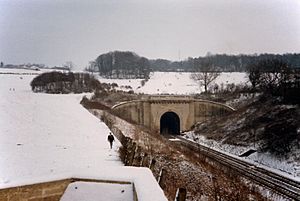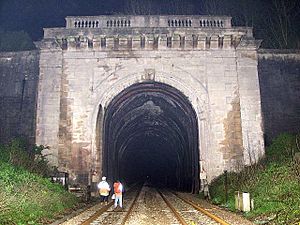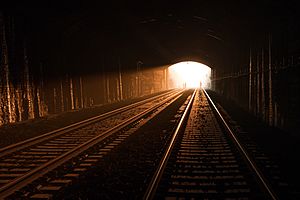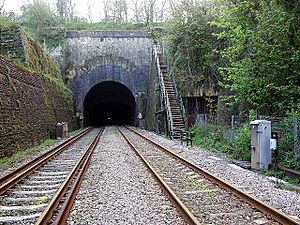Box Tunnel facts for kids
 |
|
| A winter view of the western portal | |
| Overview | |
|---|---|
| Line | Great Western Main Line |
| Location | Box Hill, Wiltshire, England |
| Coordinates | 51°25′17″N 2°13′34″W / 51.42128°N 2.22617°W |
| Status | Open, operational |
| Operation | |
| Work begun | December 1838 |
| Owner | Network Rail |
| Operator | Network Rail |
| Technical | |
| Length | 1.83 miles (2.95 km) |
| Operating speed | 125 miles per hour (201 km/h) |
| Grade | 1:100 |
The Box Tunnel is a famous railway tunnel in England. It goes through Box Hill and is part of the Great Western Main Line (GWML). This line connects cities like Bath and Chippenham.
When it was finished in 1841, the Box Tunnel was the longest railway tunnel in the world! It is about 1.83 miles (2.95 km) long.
It was built for the Great Western Railway (GWR) between 1838 and 1841. A brilliant engineer named Isambard Kingdom Brunel led the project. The tunnel goes downhill slightly from its eastern end.
Building the tunnel was very difficult and even dangerous because of its length and the types of rock underground. Today, the tunnel's western entrance is a special historic site. The eastern entrance is also protected.
During World War II, old mine tunnels near Box Tunnel were used to store ammunition. In recent years, the tunnel has been updated. Its tracks were lowered to get it ready for electric trains.
Contents
History of the Box Tunnel
Planning the Railway
In the 1830s, Isambard Kingdom Brunel planned a railway line from London to Bristol. This line, called the Great Western Main Line, was designed to be mostly flat. However, between Swindon and Bath, the line reached its highest point. Here, Brunel suggested building a tunnel through Box Hill. This area is just outside Corsham.
The tunnel would have a steep slope inside, going down 1 foot for every 100 feet of length. Some people at the time worried about this steep slope. The Box Tunnel would also be the longest railway tunnel ever built, nearly 1+3⁄4 miles (2.8 km) long.
Understanding the Ground
Building the Box Tunnel was seen as a huge challenge. Engineers worried about its length and the difficult rock layers it would pass through. The main rock was Great Oolite limestone, also known as Bath Stone. This stone is easy to work with and had been used for building since Roman times.
To understand the ground better, Brunel dug eight deep shafts along where the tunnel would go. He did this between 1836 and 1837.
Building the Tunnel
The main builder for the tunnel was George Burge. He was in charge of 75 percent of the tunnel, starting from the western end. Another company, Lewis and Brewer, built the rest from the eastern side. William Glennie, one of Brunel's helpers, oversaw the whole project.
Construction began in December 1838. The work was split into six parts. Workers could get to each part through large ventilation shafts. These shafts were about 25-foot-diameter (7.6 m) wide and ranged from 70 feet (21 m) to 300 feet (91 m) deep. Men, tools, and materials went in and out of these shafts. Steam-powered machines helped lift out the 247,000 cubic yards (189,000 m3) of rock and dirt. These shafts also served as safety exits.
Candles were the only light inside the tunnel, and workers used about one tonne of candles each week! They also used a lot of explosives. Blasting happened while workers were still inside the tunnel. This, along with unexpected amounts of water, caused many deaths. About 100 workers, called navvies, died during the tunnel's construction. Large amounts of water in winter made the work even harder.
The eastern part of the tunnel was blasted out and left without a brick lining. The western part was dug with picks and shovels and then lined with bricks. Over 30 million bricks were used. They were made in nearby Chippenham and brought to the site by horse-drawn carts. Horses also helped remove much of the dug-out material.
The difficult conditions caused delays. By August 1839, only 40 percent of the tunnel was done. The rest of the Great Western Main Line was finished, but the Box Tunnel was the last part. Brunel worked hard to speed things up. In January 1841, he arranged for the workforce to increase from 1,200 to 4,000 people. The tunnel was finally completed in April 1841.
The finished tunnel was 30 feet (9.1 m) wide, big enough for two broad-gauge tracks. When the two ends of the tunnel met, they were off by less than 2 inches (50 mm)! Brunel was so happy that he reportedly gave a ring from his finger to the foreman.
Opening and Design
The Box Tunnel opened on June 30, 1841, without a big ceremony. A special train left London and traveled the entire GWR line, reaching Bristol in about four hours.
Work continued for several months after the opening to finish the western entrance. Brunel designed this entrance in a grand classical style. It is much grander than the eastern entrance because it faces the main road from London to Bath. The opening is much taller than needed, making it look like a huge monument to this new way of travel. Its height looks even greater now because the tracks were lowered in 2015 for electric trains. The eastern entrance at Corsham is simpler, made of brick with stone details.
Some people worried that the unlined parts of the tunnel were unsafe. The GWR built a brick arch under part of the unlined section to protect it from frost damage. However, some areas of the tunnel still remain unlined today.
Brunel's Birthday and the Sun
There is a popular story that the sun shines all the way through Box Tunnel on Isambard Kingdom Brunel's birthday, April 9. However, in 2017, the GWR train company checked this and found it wasn't true.
A librarian named C.P. Atkins calculated in 1985 that the sun would shine fully through the tunnel on April 7 in most years, and April 6 in leap years. In 2016, the Society of Genealogists suggested the sun might have shone through on April 6, which was the birthday of Brunel's sister, Emma Joan Brunel.
Defence Use of Nearby Quarries
Starting in 1844, the hill around the Box Tunnel was heavily quarried for Bath stone. Before World War II, the UK needed safe places to store ammunition. In the 1930s, plans were made for three large ammunition depots. One of these was at Tunnel Quarry, near Box Tunnel.
In the 1930s, the Royal Engineers prepared Tunnel Quarry as a major storage site. In 1937, the GWR built a long loading platform and two railway sidings (extra tracks) near the tunnel's eastern entrance. Below this, the War Office built a narrow-gauge railway yard. This yard connected to a 1.25-mile (2.0 km) tunnel that sloped down to the ammunition depot inside the old quarry. This system was designed to handle up to 1,000 tons of ammunition every day.
A Royal Air Force base, RAF Box, also used parts of these tunnels. During the Bristol Blitz in 1940, a factory for aircraft engines was set up here by Alfred McAlpine. It was meant as a backup for the Bristol Aeroplane Company (BAC). BAC used the site for its experimental department, which was developing engines for bombers and the Bristol Beaufighter.
The ammunition depot closed after the war but was kept ready for use until the 1950s. The railway sidings were removed. Later, parts of the depot were used for other facilities, including a secret government war headquarters and a computer centre.
Today, only the former computer centre remains active. The northern entrance to the tunnel complex has been sealed with concrete. The old ammunition depot is now used to store commercial documents securely.
Electrification Updates
In the 2010s, the Great Western Main Line was updated for electric trains. This meant installing overhead power lines, called catenary. The Box Tunnel needed to be changed to fit this new equipment.
In the summer of 2015, the tunnel was closed for six weeks. During this time, workers lowered the track by about 600 millimetres (24 in). They also replaced seven miles (eleven kilometres) of cables. These changes prepared the tunnel for the new electric power lines.
Box Tunnel in Fiction
- An episode of the TV show McDonald & Dodds takes place around the Box Tunnel. The story of the sun shining through the tunnel on Brunel's birthday is an important part of the plot.
See also
- List of tunnels in the United Kingdom
- Stapleford Miniature Railway
Images for kids









